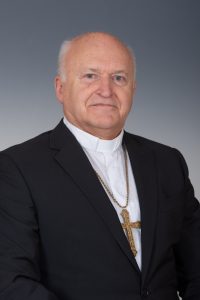MSGR. DR. LADISLAV NEMET, ARCHBISHOP AND METROPOLITAN OF BELGRADE

MSGR. STANISLAV HOČEVAR, THE ARCHBISHOP EMERITUS (the Archbishop from 2001 to 2022)
Msgr. Stanislav Hočevar was born on November 12th, 1945 in a village Jelendol, a parish and municipality Škocjan near Novo Mesto, the Diocese of Novo Mesto, Slovenia. After completing primary school in Škocjan, he joined the Salesians of Don Bosco in 1960. He attended grammar school in Križevci and Rijeka, and then he entered the Salesians’ novitiate. He served in the Army in Skopje from 1966 to 1967. Then he was an educator in the novitiate in Želimlje near Ljubljana. He studied theology at the Faculty of Theology in Ljubljana. He was ordained as a priest on June 29th, 1973.


He was a deputy Salesian Provincial in Slovenia for two years (1982-1984). Then, he was a director of a boarding school for high school students – Modesto’s home in Klagenfurt, Austria for four years. He was elected Provincial of the Salesians in Slovenia for the first time in 1988, and he was entrusted with his second term in the same department from 1994 to 2000. He took part in four General Meetings of the Salesians in Rome. He was the President of Conference of Major Religious Leaders of Slovenia in two terms, and then he was the Secretary General of the same conference for two years.
Even with these demanding responsibilities and duties, he found time to write. His booklet Peter s Poljske was published in 1978, Odpri srce in 1983, Veliko znamenje – readings for May devotion in 1988, and in 1998 he was the editor of Leta velikog dozrevanja, a book about all victims of the Second World War in the local parish in Škocjan, near Novo Mesto.
During the bombing of Yugoslavia, in 1999, he started the initiative “Peace to you, Balkan” and in the same year he established a successful foundation to help multiple-child families named Anna’s Fund. Pope John Paul II appointed him the Coadjutor Archbishop of Belgrade on feast of the Annunciation on March 25th, 2000. He received Episcopal ordination in the church of Our Lady of Help in Rakovnik, Ljubljana, on May 24th, 2000. He came to Belgrade on Pentecost in 2000. At the plenary session of the Bishops’ Conference of Yugoslavia in 2000, he became responsible for catechesis, the youth and monastic life, and he also became the president of the Bishops’ Commission for Caritas.
Holy Father John Paul II accepted the request for dismissal of the former Archbishop of Belgrade Dr. Franc Perko on March 31st, 2001, and with this Msgr. Stanislav Hočevar takes over the position of the Archbishop and Metropolitan of Belgrade.
On April 16th, 2001, he was elected President of the Bishops‘ Conference of Yugoslavia, later renamed the International Bishops’ Conference of St. Cyril and Methodius, where he also performed other functions, and he was entrusted with another five-year term on June 7th, 2006, at XVI Plenum in Petrovaradin,.
He became a member of the Pontifical Council for Promoting Christian unity in 2002. There is a star and a harp on the bishop’s coat of arms which belongs to Msgr. Stanislav Hočevar. The star indicates transcendent dimension of human life, and therefore symbolizes Church and the Virgin Mary; the harp is an instrument that speaks of harmonious unity, and symbolic number seven represents sacraments of the Church. These symbols indicate light and hope that Christianity brings. The colors on the background of the coat of arms are typical Slovenian colors.
According to the decision of Pope Francis, from the day of appointment of Msgr. Ladislav Nemet as Archbishop of Belgrade, November 5, 2022, Msgr. Stanislav Hočevar, the retired Archbishop of Belgrade, will manage the Belgrade Archdiocese as an apostolic administrator until the day of the enthronement of the newly appointed Archbishop Nemet.
Motto of his Episcopal vocation is: Servite Domino in laetitia (meaning: Serve the Lord with joy).








 .
.